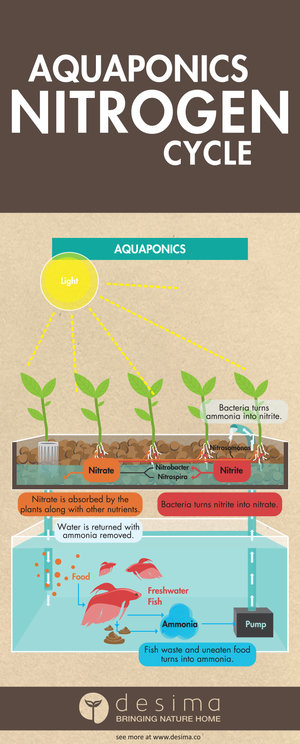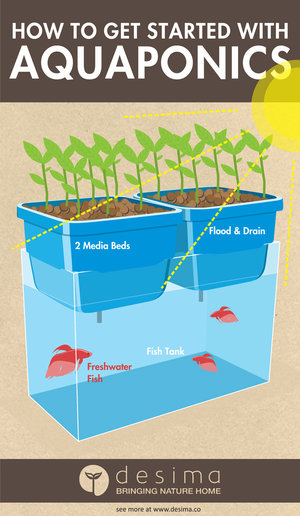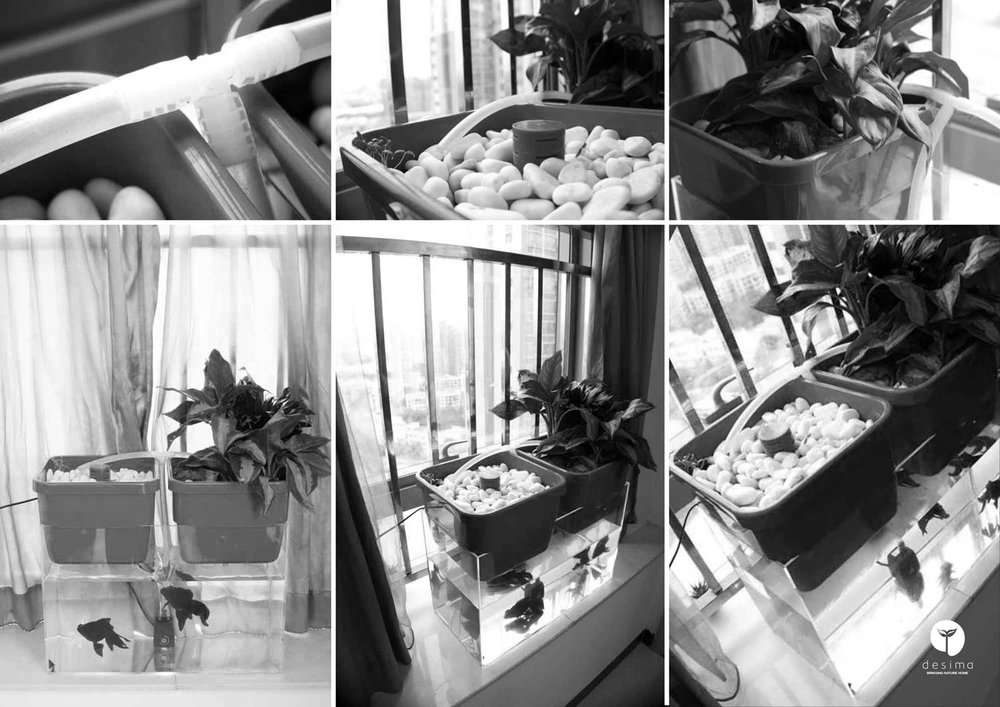What is aquaponics?
Aquaponics is a way of growing plants and aquatic animals together in the same system. It is the combination of the two conventional farming techniques, aquaculture and hydroponics. Aquaculture is the farming of aquatic animals like fish and shrimps. In hydroponics, plants are grown in water using mineral nutrient solutions, without soil. So, aquaponics is growing of plants while rearing aquatic organisms together. In this great combination, fish and plants live in a symbiotic relationship. Fish in the water tank excrete waste. The water in the tank that contains fish waste is pumped out to the media bed where plants grow. There are bacteria in the media bed and they convert the fish waste in to smaller absorbable compounds. These are the nutrients for plants that they use for their growth. So plants absorb the nutrient compounds in this media bed. In another way, plants have helped to purify the fish waste in water. This cleaned water is returned back to the fish tank. It is a symbiotic relationship where fish feed the plants and plants clean water for fish to live in.
In aquaculture the waste from aquatic animals accumulate in water and increase the toxicity. Fish excrete ammonia as a metabolic product. Higher concentration of ammonia is toxic to fish. Excess ammonia can cause diseases and even death, so need to be removed from the system. The nitrogen cycle circulates these products within the system and helps detoxify the water.

Illustration of the Nitrogen cycle in aquaponics
Nitrogen Cycle
Bacteria play an important role in aquaponics systems by performing major steps of the nitrogen cycle. In aquaponics systems, the bacteria colonies form on solid media surfaces. The toxic ammonia, released by fish, is broken down to nitrites and then to nitrates, which are lesser toxic to organisms than ammonia. This process is called the nitrification. The two groups of bacteria, Nitrosomonas and Nitrobacter are involved in nitrification. Nitrosomonas convert ammonia to nitrites and Nitrobacter convert these nitrites to nitrates. The toxicity of nitrites is lesser than ammonia and nitrates are even lesser toxic than nitrites. Plants absorb both these nitrites and nitrates. On the other hand, now the water is clean, without ammonia, and is sent back to the fish tank.
The bacteria are a group of microorganisms, which are minute and cannot be seen by our naked eyes. Though some bacteria cause diseases and harmful to humans some bacteria are helpful and essential for us. Nitrifying bacteria are those who convert ammonia to nitrites and nitrates, like Nitrosomonas and Nitrobacter. They are kind of helpful bacteria. Nitrites (NO2- ) and nitrates (NO3- ) are two forms of ions, soluble in water, produced in the nitrification process in the nitrogen cycle. These ions are easily absorbable by plants and they are essential plant nutrients. But for fish, these ions are toxic, if accumulated in higher concentrations in water.

Source: https://www.evanimal.com/MISE-MAGAZINE
Aquaponics and sustainable living
Aquaponics is a way to produce organic food without adding chemical fertilisers. Both the harvest of plants and the fish produce can be consumed. Not only that, it uses the resources to the maximum. It has an efficient water usage. Recirculation of water between the water tank and media bed ensures the maximum usage of water. You don’t have to purchase nutrients regularly for your plants. You only have to buy fish feed. It is an environmental friendly way of sustainable food production, providing meat (fish) and vegetables.
The resources in the nature are declining and the world needs more sustainable food production to feed the growing population. If you can practice aquaponics, may be in commercial scale one day, you are contributing to fulfil this need in a sustainable manner. If you do it small scale now, you can enjoy the fresh organic harvest of plants and fish produce at your own home, in a sustainable manner.

My first aquaponics system
If you are going to build an aquaponics system for the first time, start smaller. There are different types of aquaponics systems. ‘Media based systems’ use a non-soil medium in grow beds. They are the most common and most suitable for home use since they are easy to maintain. Deep water culture (DWC) / raft based and NFT (nutrient flow technique) are two other types of aquaponics systems. DWC is the preferred system among commercial scale growers.
Though an aquaponics system has complex chemical conversions of nutrients by microorganisms, setting up of a small scale aquaponics system is not that hard. The basic things you need are water-pump, air-pump, water heaters and media for plants. A water pump is used to pump water from the tank to the growing beds. You need to select suitable plant varieties and fish types. Leafy green vegetables are popular as plants suitable for aquaponics.
As growing media you can use river rocks, but be aware of limestone. Rocks that contain limestone change the pH of your water. Another option is clay balls that can be purchased. The bacteria forms colonies on the surfaces of your media rocks, so the media should have the maximum surface area. Over time media beds will build up solids. Your system may need to be cleaned every 7 months if you do not have enough filtration. Worms may take over a role in your system. They digest any organic matter in water.
Do you want a bigger system? This might be a question in your mind. The decision to move to a bigger system should be chosen wisely at the correct time. If you need to rear more fish and grow more plants or you need an income from this, you can think about moving to the next level. Generally speaking, larger systems are easier to maintain, more constant water temperature and less fluctuations in water quality. However it’s best to get experience on a smaller set up first. Our Aqua Garden system is good for an intermediate stage. For a commercial scale system, you will need a land area and capital investment. Once you are confident with the management of aquaponics systems and you have basic knowledge and adequate skills you can go to a bigger scale system.

The Best Fish for Aquaponics (Infographic updated in 2017
How to select best fish for aquaponics?
Choosing the best fish for your aquaponics system depends on several factors. You may rear fish as an ornamental or for your consumption. Some major things to consider, when selecting fish for your system are, environmental conditions, feed source, your purpose and size of the fish and tank. Are you living in a hot, cold or tropical weather? The fish type you select should be able to tolerate your environmental conditions. The fish should match to the size of your tank. Some fish grows bigger and some fish, even they are small, need a big space to swim through. Also, importantly, check whether the fish type you select does not have legal restrictions. Some fish are prohibited to be cultivated in certain countries. Most commonly used edible fish types are Tilapia, Barramundi and Murray Cod. The favourites among ornamental aquaponics growers are Gold fish, Koi and Siamese Fighting Fish (Beta). Fish types have their own features that you need to consider when selecting them to be in your tank. If you use Siamese fighting fish, you cannot put more than one in a single tank as they fight with each other. You need to select a fish feed, like fish food or dead fish, depending on your fish type.
Gold fish is a great option for you as a starting aquaponics grower. They can live well in a wide temperature range between 10 to 23C (50 to 74 F). Not like Siamese fish you can put any number of Gold fish in one tank. Gold fish are the easiest to get started with because of the wide range of conditions and temperatures they can endure. When you are starting out in aquaponics, Gold fish are recommended as they are the easiest to work with.
How to maintain your aquaponics system
After setting up your aquaponics system you need to wait some time before adding fish. At first, use a source of ammonia such as urine or seaweed extract. This is to cycle your aquaponics system. Bacteria colonies form during this time. The aquaponics system should have built up its cycle before adding fish. For a small system, it takes about 6- 8 weeks to run smoothly. Ensure proper circulation and then you can add fish after this time.
Once your aquaponics system is established and running, you need to maintain it to ensure the smooth functioning. It is essential to test your water regularly. The parameters you have to check are the pH, temperature and water quality. Temperature should be in the range suitable for your fish type.The pH is one of the most important factors you need to check.
i. Monitor the pH in your aquaponics system
PH is a measure that gives an idea about the acidity or alkalinity of a solution. Your aquaponics solution has free ions in it. The pH measures the concentrations of the ions that are responsible for acidity and is measured in a scale ranges between 0- 14. Pure water has pH 7, which is neutral. The values below 7 are acidic and above 7 are alkaline. The solutions have a certain pH value where pH 1 is extremely acidic and pH 14 is extremely alkaline (basic). The proper pH for an aquaponics system is 6.0 – 6.4. Some ions become unavailable for plants at pH values higher than 7 or at too low pH values. This unavailability means, though the nutrients are present in the solution plant roots cannot absorb them.
The aquaponics systems tend to reduce pH with time due to the nitrogen cycle. Nitrification adds nitrites and nitrates to your system and these ions make the water acidic, means the pH value goes down. This can be adjusted and bring the pH back to the ideal by adding the correct chemicals. If pH goes down, add an alkaline compound and if pH goes up, add and acidic compound that suit. It is also good to add a buffer solution, which can maintain the pH at a desired value. You can use a pH test kit to test the pH of your water. If the pH has risen, to lower it down, you can add nitric or phosphoric acid. There are things that you need to consider when adding these chemicals. Some chemicals may not suitable for your system. For example, phosphoric acid can cause a high growth in algae, so you need to control. Also, avoid citric acid. It is anti-bacterial and will kill your helpful microorganisms. On the other hand, your system’s pH may have gone down and you need to increase it. Try adding calcium carbonate or potassium carbonate or hydroxides of them. Dissolve these chemicals in water and add gradually to your system over a time period while testing the pH. Do not get the chance of a huge pH change in your system as these chemicals are strong and can change your systems pH dramatically. Always wear gloves when handling these chemicals. They can burn your skin. Simply, add the suitable chemical in a safe way to your system.
ii. Add nutrient supplements, if needed
Plants rely on a combination of nutrients. Some of them, like nitrogen (N), phosphorus (P) and potassium (K), are needed in large quantities and known as macronutrients. The nutrients that are needed in minute amounts are called micronutrients. Some examples are iron (Fe), magnesium (Mg), zinc (Zn) and copper (Cu). You may need to add some nutrients like N, P, and K to your aquaponics system as they are not available in fish food and not excreted by fish, but essential for plants. Calcium and iron are also required as supplements. You can add them at regular intervals or when plants show deficiency symptoms. When adding nutrient supplements, you should adjust the pH. Normally potassium and calcium is added as carbonates or hydroxides to increase pH. In this case you are actually adding the potassium and calcium nutrient supplements to your plants. The nutrient supplements can change the pH level of the system. So, best thing is to adjust the pH at the same time you add your nutrient supplements.
iii. Test water regularly and keep records
Test your water and keep notes on them. This help to understand how your system performs.
iv. Know when to harvest your produce
Have a variety of plants that you harvest at different times, so there are always plants to clean the water. The balance between plants and fish is important to maintain the equilibrium in the system.There should be enough plants at every time to remove the waste products of fish. If there is a large number of fish compared to the plants, the toxics may not be removed by the plants completely. This can cause fish diseases and may eventually lead to deaths. If you select different varieties of plants that are suitable for different times, then you always have plants for your system.
v. Check your system components
Ensure good circulation of water between the fish tank and media bed. Poor circulation results in poor oxygen content in your system. A good circulation will reduce the risk of plant and fish disease outbreaks. You can use a filter to avoid entering of particles in to the growing beds. Solids filtration will keep your system running healthier for longer. Keeping backup equipment is also a good idea.
vi. Control the pests
A good pest control plan will keep unwanted insects and pests away from your system. You can choose cultural, biological, physical or chemical pest controlling methods. Each method has advantages and disadvantages and can be selected according to your needs. These should be handled in a safe manner and some methods need extra care. Remember to be very careful when using chemical pest controlling methods, as the chemicals can get in the water and affect the fish.

The Aqua Garden by Desima
‘Aqua Garden’, your first aquaponics system
If you are going to purchase an aquaponics system for the first time, Aqua Garden is a good starter for you. Aqua Garden is a desktop aquaponics system that you can keep on any table, specially designed for home usage. It is ideal for start-ups and you can get started quicker.
Aqua Garden is small enough to go indoors. It includes an acrylic fish tank, 2 bell siphons and 2 media beds. The kit comes with comprehensive instructions. It is great for your desktop in the living room or your garage or even your high-rise roof top. For those in colder climates, Aqua Garden is small enough to be used indoors and thus easier to keep warm for your plants and fish.
Aqua Garden is simple and smaller system to learn first on. Especially, if you are totally new to aquaponics, or you have only had a small ornamental setup, then the Aqua Garden will be the best to learn this farming technique. It is small enough to keep on your desk and big enough to grow your vegetable plants. Most of the desktop aquaponics systems available in the market are not large enough for vegetable plants. But in Aqua Garden, each media bed is large enough for you to grow a tomato plant in it. It is easy to maintain. You do not have to be afraid to start at this small scale. It is ideal to improve your skills and learn to manage your aquaponics system. You will soon be able grow your own healthy organic vegetables and fish at home. May be next you’ll have your very own full size farm.
